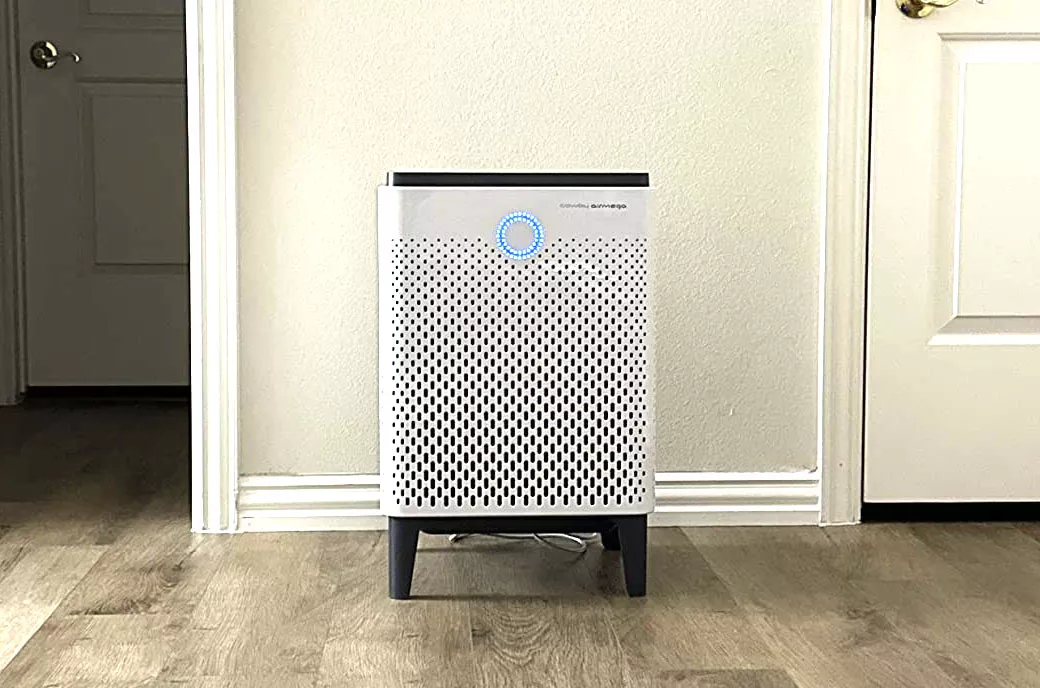Are Coway Airmega air purifiers worth it?
If you know one thing about me, it’s most likely that I absolutely can’t stand overpriced garbage.
And one of the worst things for me is seeing family and friends fall for marketing hoaxes … So, I hope I can at least save you, dear reader.
My name is Daniel, I am an electrical and aerospace engineer. And no HVAC company is safe from my bare honesty!
After roasting Dyson cooling fans, today is the day where we check Coway Airmega air purifiers together and whether they are worth their cost.
And instead of checking the specs one by one (as 99% of product reviewers do), we’re going to check
- whether Coway lies and uses marketing tricks
- how Coway Airmega compares to other (regular) air purifiers
- if buying a Coway Airmega is worth it
Coway Airmega air purifiers come in different sizes.
There’s the Airmega 200M, 300, 400, and ProX(click to view them on amazon), and many more (each model getting more expensive, ranging from $200 to $400 and up to over $800).
Coway Airmega air purifier marketing claims (myth busted)
All Coway Airmega models have one thing in common: A huge set of marketing claims.
And it looks like Coway copy-pastes these marketing claims from sales page to sales page.
They merely adjust the coverage area.
That’s it.
So, let’s have a look at some of Coway’s marketing claims and see if they hold any substance.
What the heck is a binary motor?
The first thing I noted looking at the Coway Airmega ProX was Coway advertising a “binary” motor.
So, what the heck is a binary motor?
As an electrical engineer, I’ve never heard of that term.
After checking Coway’s official ProX product page, I saw a simple image of the Airmega ProX containing two fans.
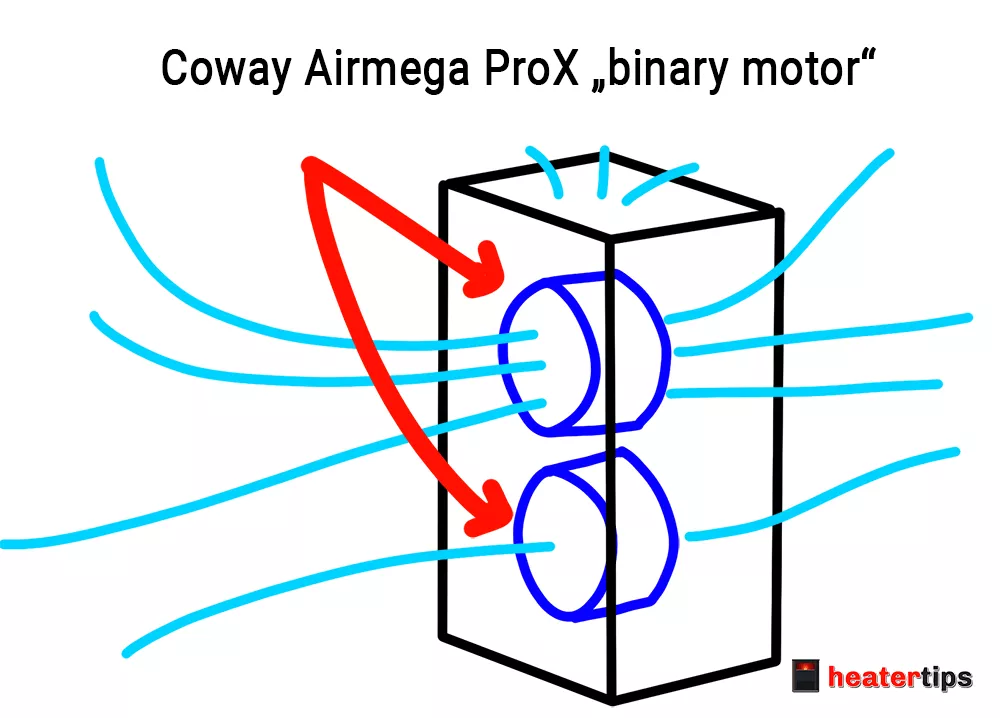
“Wow, that’s great. Doesn’t that mean that it has twice the air purification power?”
No!
Having two built-in fans does not improve air purification. What matters is the built-in fan’s airflow. And the more power your air purifier has, the more airflow it provides.
As simple as that.
So, I decided to check the ProX technical specs and saw that it consumes 65W of power.
That’s nothing special. It does not matter whether an air purifier has two fans consuming a total of 65W of power, or a single fan, consuming that much power.
In fact, I’d argue a single fan might even be better since there are fewer moving parts (so, less chance of anything breaking) and less internal friction which causes power loss.
The binary motor is merely a cost choice. Most likely, Coway Airmega ProX reuses the fans from the smaller Airmega 300 and 400 models. Since the Airmega ProX needs something to “stand out”, Coway decided to use two fans and run each on reduced power.
And here’s the funniest part: The Coway Airmega ProX does not even create more airflow than the Airmega 400, which consumes a similar 64W - 67W max.
So, there is absolutely nothing that makes a binary motor better than a single motor.
Coway Airmega “binary” motors are pointless. They don’t improve air purification.
The “Designed to clean spaces up to … sq. ft.”-claim
Every single Amazon Coway air purifier sales page starts with listing the “Coverage within 30 mins” as the most important first bullet point.
Apparently, that’s the room size a Coway air purifier can clean within 30 minutes of running.
Now, let me list the coverage areas and the power consumption of a few Coway Airmega models. Something interesting is going on there:
| Air Purifier model | Coverage area in 30 mins (in sq. ft.) | Power consumption (in Watts) |
|---|---|---|
| Coway Airmega 200M | 874 sq. ft. | 82 W |
| Coway Airmega 300 | 1,256 sq. ft. | 57 W |
| Coway Airmega 400 | 1,560 sq. ft. | 66 W |
| Coway Airmega ProX | 2,126 sq. ft. | 65 W |
I’ve ordered the air purifiers by their coverage area. Now take a look at the power consumption (according to official Coway specs):
The Airmega 200M air purifier has the smallest coverage area and consumes the most power.
Meanwhile, the Coway Airmega ProX allegedly covers an area of 2,126 sq. ft., while consuming less power than both the Airmega 200M and 400.
To me, this is counterintuitive. To cover larger areas, you need a higher airflow which directly translates to more power.
So, two things are likely going on here:
Either Coway makes up the coverage area ratings, or the power specification is not correct. In either case, the customer is deceived.
A third (unlikely) scenario is possible as well:
The ratings are correct, and the (small) Airmega 200M consumes 26% more power than the large ProX while covering a 59% smaller area because it is incredibly inefficient.
Coway’s Dual Suction Purification
The larger Coway Airmega models (300, 400, and ProX) advertise “Dual Suction Purification”.
Sounds fancy, but, in the end, the “dual suction purification” just means that there are two built-in filters: one on each side of the air purifier.
On Coway’s ProX product page, I find the following statement:
“Dual-sided air intake pulls in contaminated air and pushes filtered air out to the top of the unit, cleaning the air you breathe faster and more efficiently.”
ProX product page
So, how do these “dual suction” air intakes help purification? Coway claims they are “cleaning the air […] faster and more efficiently”.
Again, this is a plain marketing statement.
Physically, it does not matter how many filters an air purifier has. The only factors for purification are (1) the total surface area of the filters, which determines the airflow resistance, and (2) the fan’s power consumption.
Accordingly, a strong fan that blows air through a large filter does a better purification job than a weak fan forcing air through a small filter.
The physics are so simple…
So, I have to admit: Technically, dual filters are a good thing since they decrease airflow resistance.
But this reduction in airflow resistance does not stem from the “dual” filters, but rather from the simple increase in filter area.
Coway’s double air intake is physically a good thing. I don’t like the imprecision they use in their marketing, however.
A better statement would be “Dual air intakes improve airflow”.
The largest downside of dual filters
There’s one thing I seriously don’t like about dual filters: Two filters cause “dual” replacement filter costs.
We will check the cost of replacement filters later. It’s horrible.
Is the HyperCaptive filtration system any good?
Coway advertises a HyperCaptive filtration system.
Here’s what they say:
“Coway’s network of diverse capture technologies takes purification to the next level, trapping and deactivating an unprecedented 99.999%¹ of particles down to 0.01 µm - smaller than most bacteria and viruses.”
Airmega 300 product page
Let’s break this marketing claim down and check the facts:
Trapping an unprecedented 99.999% of particles
Claiming to trap an unprecedented 99.999% of particles is one thing. But it is misleading.
In one study, researchers tested the particle collection efficiencies of HEPA filters with varying particle sizes.
Here’s the result:
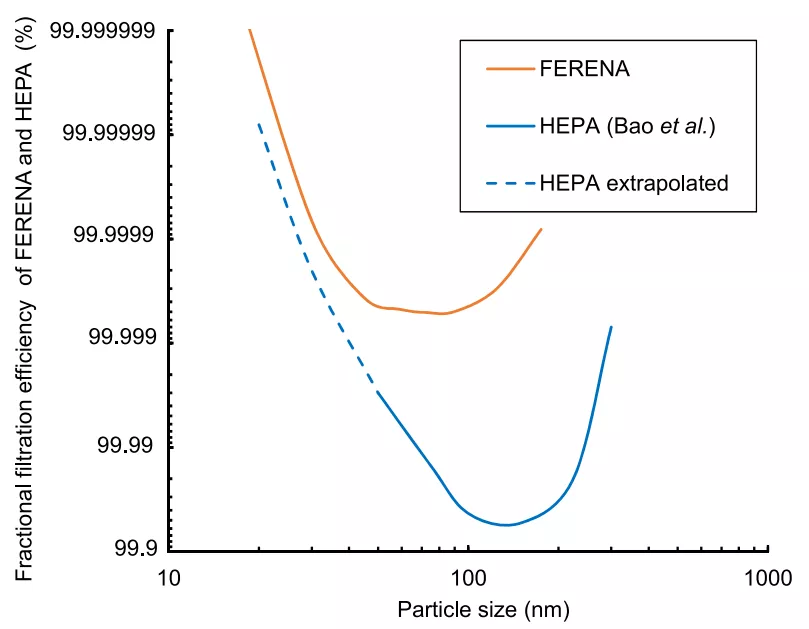
As you can see, the filtration efficiency is above 99.999%(for a regular HEPA filter) for particles smaller than 40nm and larger than 0.3µm.
At around 100nm, there is a minimum filtration efficiency of around 99.95%.
And that’s what Coway is actually advertising:
They are saying:
“In the worst possible range, where HEPA filters have “problems” picking up particles, we at Coway are doing 0.049% better.”
reformulated actual Coway marketing statement (by me)
But of course, you don’t see them advertising this. Because it sounds pointless.
There is no reason to pay hundreds of dollars extra on a Coway Airmega air purifier (as compared to a regular air purifier) to justify 0.049% better performance for particles between 40nm and 300nm.
Additionally, I checked Coway’s disclaimers to see how they measured the 99.999% filtration efficiency: no study linked.
Even though they put the superscript 1 (¹) after their claim (“99.999% ¹”), which indicates that there is data to back this claim up:
Nothing.
All I see is:
“Coway air purifiers has been proven to trap dust, pollen, dander, viruses and bacteria in the air based on KCL (Korea Conformity Laboratories) testing."
disclaimer section of Coway products
The testing standard is called “SPS-KACA 002”.
Here’s what the only dust chamber testing for that standard looks like:
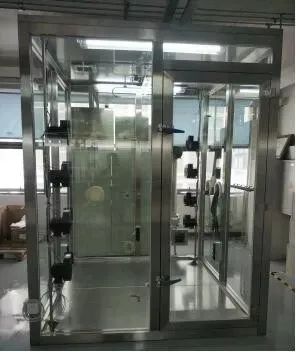 Huanyi Chamber (Hong Kong) - Did Coway test their filters here?
Huanyi Chamber (Hong Kong) - Did Coway test their filters here?
One interesting thing I found here: The Huanyi testing chamber website describes the testing process. Here’s what they say is one testing step:
Test step in Chinese testing facility: “Measure the reduction of particles with a particle size of 0.3µm”
To me, that sounds as if the testing procedure covers only 0.3µm particles.
So, what is going on? Coway links no test data validating their marketing claims.
All I can tell is that there have been tests, likely in Hong Kong, and we don’t get access to the actual test results.
Merely a claim.
And even if that claim was true, it’s just a 0.049% improvement over the standard.
Trapping and Deactivating particles
Coway’s filters trap and deactivate particles. Sounds nice!
It suggests that after trapping, their HEPA filters have some additional mechanism to “kill” particles.
Of course, that is physically not possible. And I strongly wonder what Coway means by “deactivating”.
Here’s what is actually going on in a HEPA filter:
HEPA filters catch particles based on 4 different mechanisms:
- Diffusion: tiny particles shaking around in the air stream until the filter catches them by chance
- Interception: a particle bumps directly into the filter
- Inertial impaction: a heavy particle can’t follow the airstream (passing through the gaps in the filter) and bumps into the filter
- Electrostatic attraction: a particle bumps into the filter because of an electric charge
All of these are different forms of “one particle bumps into the filter for whatever reason”.
Aside from trapping particles, there is no further mechanism in a HEPA filter.
A HEPA filter does not “deactivate” anything.
Suspiciously, there is no disclaimer about the deactivation part of Coway’s marketing statement.
This is a plain lie.
Readvertising the same function as different features
Coway Airmega air purifiers have built-in air pollution monitoring. They call it “24/7 air pollution monitoring”.
The “24/7” is redundant. Any electric device is a 24/7 device if I run it for 24 hours a day.
For example, my fridge is a 24/7 fridge. Just as my smoke detector is a 24/7 smoke detector.
It makes no sense.
On top of that, anything other than 24/7 would make pollution monitoring pointless. Why should it ever turn off? It’s a monitoring mechanism.
Imagine your home’s smoke detector turns of at certain hours.
This way, Coway makes something usual sound like it’s something special.
But that’s not it.
The 24/7 air pollution monitoring is “saving [you] energy when [the air purifier] is not needed”.
When pollution levels are down, the air purifier turns off.
Nice. This adaptive air pollution-based airspeed control makes sense. Coway calls this “Smart Mode” (There is nothing smart about a regular electrical control circuit by the way. They are used everywhere).
But Coway apparently can’t stop there.
They have to bloat it (again):
Now, on top of the air pollution-based “Smart Mode”, the Coway Airmega air purifiers have two more modes:
- “Eco Mode”: Monitors air pollution and turns the fan on or off accordingly
- “Sleep mode”: Monitors air pollution and adjusts fan speed when it’s dark
In principle, all those three different modes do the same thing. “Smart Mode”, “Eco Mode”, and “Sleep Mode” all monitor air pollution and set the fan accordingly.
There are some slight differences. But is it really necessary to bloat these features up so much that they make up more than half of the product description on Amazon?
Can’t you just say “Air pollution monitoring and automated fan speed control modes”?
I mean it’s nice that Coway Airmega air purifiers monitor pollution levels. But they absolutely oversell it.
Usually, it’s enough to just run your air purifier all the time and adjust settings as you need. Air purifiers consume next to no power, so adaptive air purification does not make that much sense.
Gas and odor removal
Coway claims it removes 99% of Food smells, Cigarette odors, VOCs, Pet odors, and dander.
Luckily this claim refers to a disclaimer, so I can check it.
And, interestingly:
“The concentration of ammonia, acetaldehyde, and acetic acid were proven to be removed […] It is not a demonstration result in the actual use space. Not all odors and gases may be supported.”
Airmega 400 disclaimer section
Explanation:
Coway tested for 3 types of gases (ammonia, acetaldehyde, and acetic acid). But these chemicals are not directly related to their marketing claims.
Coway claims that the Airmega models remove everyday smells. But they test it in a lab, with unrelated test tube chemicals. Not very authentic.
Coway claims to remove 99% of food smells, cigarette odors, VOCs, and pet odors. But they did not perform any experiments to validate their claims.
Interestingly they say this result does not demonstrate how the Coway Airmega works in the actual “use space” (at your home).
So, they admit that their claim has no direct backing.
What’s particularly bad about Coway Airmega air purifiers
So far, we checked the Coway Airmega series’ marketing claims. And, to be honest, I am seriously disappointed.
But it gets way worst. Let’s have a look at what’s particularly bad about Coway Airmega air purifiers outside of their marketing claims.
Coway Airmega 300 and 400 stand on feet (elevated)
The Coway Airmega 300 and 400 models have attached feet to stand on.
These may look nice but actually have a negative impact on dust collection.
An air purifier should always stand close to the ground to create an air draft along the floor. This allows the air purifier to pick up dust particles that already settled on the ground.
The higher an air purifier stands on its feet, the higher it has to lift these settled particles, and the harder it gets to do so.
An air purifier standing on its feet can’t effectively pick up floor dust.
In principle, that’s not a critical problem, since you bought an air purifier and not a vacuum. But I like the idea of my air purifier also picking up dust from the floor.
Why should you inhibit this functionality by placing your air purifier on feet? There’s no reason.
And if I spend $500 on a Coway Airmega 300 or 400, I want it to pick up all the particles in my home. Not just those floating around in the air.
Filter replacement costs
Coway’s replacement filter costs are absolutely infuriating.
One set of non-original replacement filters costs about $50.
| Air Purifier Model | Replacement Filter Cost |
|---|---|
| Coway Airmega 300 | $99 |
| Coway Airmega 400 | $129 |
| Coway Airmega ProX | $199 |
Original Coway Airmega replacement filters cost up to $199. What a rip-off!
Thankfully, they advertise you get a “20% off filters coupon with registration”. So, after you provide them with your valuable data (so they can send you advertising emails), they will sell you a filter for $160 instead of $199.
How nice…
Such a filter costs very little in production. Coway blows up filter replacement prices artificially. No HEPA filter is worth $99 - $199.
These price politics show how Coway tries to position itself: as a luxury air purifier brand.
Similar to how original luxury car part prices go totally overboard, Coway blows up their replacement part prices.
After all, once you buy a $500 - $1,000 Coway Airmega air purifier, they expect you to not bother paying up to $99 - $199 for replacement filters.
Coway Airmega target customer demography
Checking all the prices on Coway’s website unveiled one more detail I want to share with you.
Below every price on Coway’s website, they advertise picking up debt (through monthly payments) in order to afford them.
Here’s an example for ProX replacement filters:
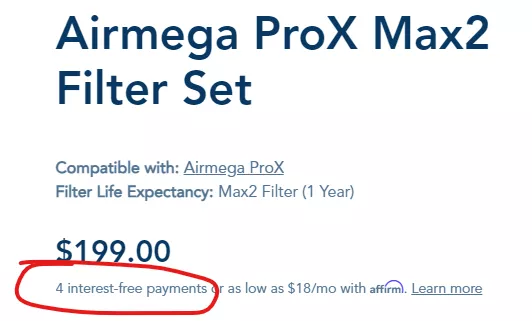 Replacement filter price of the Airmega ProX.
Replacement filter price of the Airmega ProX.
Apparently, Coway markets their luxury Airmega air purifiers to people who can’t afford them.
Why is that?
Because Coway Airmega air purifiers are not actually luxury items. Based on the myth-busting checks earlier, we can now tell that Coway Airmega air purifiers are mostly regular air purifiers.
They have a couple of additional features here and there. But overall, there is nothing inherently, technically special about a Coway Airmega air purifier.
To not have to compete with other technically sound and reasonably priced air purifier brands such as Levoit or Germ Guardian, Coway positions itself in a higher price category with much less competition.
Their mantra is that finding one person naive enough to pay $500 - $1,000 for a regular air purifier is easier and more profitable than competing with other air purifier brands in a lower price category.
If Coway really tried to create luxury items, they would build aluminum casings with a nice finish. They’d have perfectly balanced and maintenance-free steel fans. And they’d invest in actual research to back up their purification claims about their filters.
Coway Airmega air purifiers are not luxury products. They are regular plastic air purifiers with regular HEPA filters.
Only their price tag is luxury.
What I like about Coway Airmega air purifiers
After all this critique, there is one thing that Coway does well.
Air pollution monitoring
I particularly like the air pollution monitoring that comes with Coway Airmega air purifiers.
That’s a neat feature.
And I truly wonder why not all air purifiers have this.
After all, a cheap Chinese air pollution sensor costs under $2. So, air purifier production costs would not increase much.
The air pollution monitoring ensures that your air purifier only runs when it’s necessary. For example, I can imagine a Coway Airmega adjusting fan speed when you run it with a window open, or when you’re cooking.
Air pollution monitoring does not save you much money. After all, running an air purifier costs under $0.01 per hour.
So, reducing fan speed by 30% because air pollution is reduced as well, does not save you much financially.
But as an engineer, I vouch for the principle of only running a device when it’s needed.
After all, it’s not only about saving money (although Coway advertises it as a power-saving feature), but also about less noise and less airflow at home.
What’s the best Coway Airmega alternative?
Coway Airmega air purifiers are heavily overpriced and ethically and scientifically questionable. Still, they are technically solid air purifiers.
Here are a few alternatives I’d recommend you buy over a Coway Airmega any time:
Levoit Core air purifiers
Personally, I like the Levoit Core air purifiers a lot. They are sound devices, have great filters, and are much more reasonably priced.
Instead of a Coway Airmega 300 or 400, I recommend getting the Levoit Core 400S(click here to view it on amazon).
It also has a built-in air pollution sensor and you can monitor the pollution level changes on your smartphone!
The Core 400 cleans more air than the Airmega 300 or 400 (according to Levoit’s and Coway’s official numbers) and costs just a fraction of the Airmega’s price.
Personally, I have the Levoit Core 300 (click to see my review) and I really dig its simplicity. It’s a high-quality device, with all the features I need (different fan settings, good filter, quiet mode), but not going overboard with automated “smart”, “eco” and whatever modes I’ll never use.
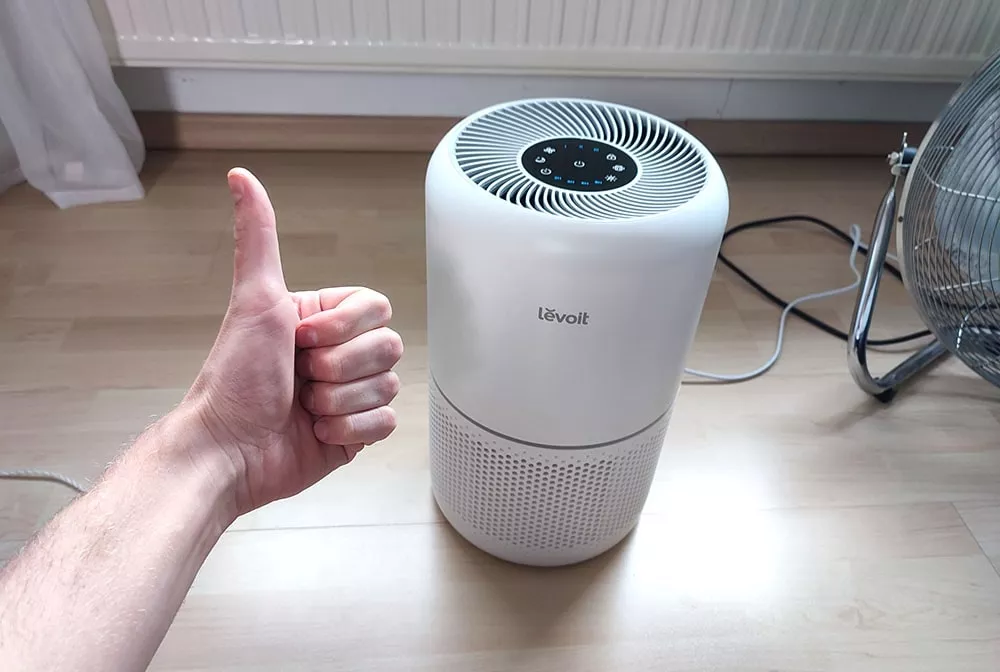
For larger spaces, and for a truly luxurious feel, you can also get the larger Levoit Core 600 (click here to view it on amazon).
The Core 600 is the best alternative for a Coway Airmega ProX air purifier. It’s strong and has a PM2.5 particle monitor (just like the ProX) but costs just a fraction of the ProX.
Of course, the Core 600 also has automatic modes where it monitors air pollution and adjusts fan speed accordingly.
There is virtually no drawback to getting a Levoit Core 600 over the expensive Coway Airmega ProX.
Conclusion: Are Coway Airmega Air Purifiers worth it?
Coway Airmega air purifiers are heavily overpriced and cost 2-3 times what comparable air purifiers cost.
Technically, there is no reason to buy a Coway Airmega air purifier:
- Coway Airmega air purifiers don’t filter air significantly better than other air purifiers.
- Coway markets its air purifiers to people who can’t afford them.
- They can’t back up their claims with actual public data. This is something I would expect at this price point.
You should buy a Coway Airmega air purifier only if you have a lot of money to waste and you dig the look and feel of Coway Airmega air purifiers.
However, if you want to get an air purifier for air purification only, I recommend getting a Levoit or Germ Guardian air purifier. They are reasonably priced.
Coway’s air purifiers don’t work any better than other good-quality air purifiers.
